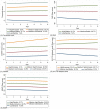Cognitive Trajectories in Community-Dwelling Older Adults and Incident Dementia, Disability and Death: A 10-Year Longitudinal Study
- PMID: 35833102
- PMCID: PMC9271785
- DOI: 10.3389/fmed.2022.917254
Cognitive Trajectories in Community-Dwelling Older Adults and Incident Dementia, Disability and Death: A 10-Year Longitudinal Study
Abstract
Objective: The inter-individual variability in cognitive changes may be early indicators of major health events. We aimed to determine whether late-life cognitive trajectories were associated with incident dementia, persistent physical disability and all-cause mortality.
Methods: Data came from a cohort of older community-dwelling individuals aged 70 years or above in Australia and the United States. Global cognition, verbal fluency, episodic memory and psychomotor speed were assessed regularly at up to seven waves between 2010 and 2017. Dementia, disability in activities of daily living, and death were adjudicated between 2017 and 2020. Latent classes of cognitive trajectories over seven years were determined using group-based trajectory modeling. Multivariable logistic regression was used for the prospective associations between cognitive trajectories and these outcomes.
Results: Cognitive trajectories were defined for 16,174 participants (mean age: 78.9 years; 56.7% female) who were alive and without incident dementia or disability by 2017, among which 14,655 participants were included in the association analysis. Between three and five trajectory classes were identified depending on the cognitive test. Cognitive trajectories were strongly associated with the risk of dementia. For example, compared to those in the highest-functioning trajectory, the worst performers of episodic memory had a 37-fold increased risk of dementia (95% CI: 17.23-82.64). The lowest trajectories of both global cognition and episodic memory also predicted increased mortality risk (OR: 1.80, 95% CI: 1.28-2.52; OR: 1.61, 95% CI: 1.09-2.36, respectively), while only slow psychomotor speed was marginally associated with physical disability (OR: 2.39, 95% CI: 0.99-5.77).
Conclusions: In older individuals, cognitive trajectories appear to be early indicators of clinically relevant health outcomes. Systematic cognitive assessments as part of routine geriatric evaluation may facilitate early identification and interventions for those individuals at highest risk.
Keywords: activities of daily living; aging; cognition; death; dementia; longitudinal.
Copyright © 2022 Wu, Woods, Chong, Orchard, Shah, Wolfe, Storey, Sheets, Murray, McNeil and Ryan.
Conflict of interest statement
AM reports receiving consulting fees from Alkahest, Inc. and grants from the National Institute on Aging. RS reports grants for clinical research regarding dementia and Alzheimer's disease from the National Institutes of Health, the Centers for Medicare and Medicaid Services, the Department of Defense, and the Illinois Department of Public Health; being as a non-compensated member of the Board of Directors of the Alzheimer's Association–Illinois Chapter; and being as a site principal investigator or sub-investigator for clinical trials and research studies for which his institution (Rush University Medical Center) is sponsored (Amylyx Pharmaceuticals, Inc., Eli Lilly & Co., Inc., Genentech, Inc., Lundbeck, Inc., Merck & Co, Inc., Navidea Biopharmaceuticals, Novartis Pharmaceuticals, Inc., Roche Holdings AG, and Takeda Development Center Americas, Inc.). The remaining authors declare that the research was conducted in the absence of any commercial or financial relationships that could be construed as a potential conflict of interest.
Figures


Similar articles
-
Trajectories of cognitive function in community-dwelling older adults: A longitudinal study of population heterogeneity.Alzheimers Dement (Amst). 2021 May 2;13(1):e12180. doi: 10.1002/dad2.12180. eCollection 2021. Alzheimers Dement (Amst). 2021. PMID: 33969173 Free PMC article.
-
Cognitive, physical and disability trajectories in community-dwelling elderly people.Aging Clin Exp Res. 2021 Oct;33(10):2671-2677. doi: 10.1007/s40520-021-01804-3. Epub 2021 Feb 16. Aging Clin Exp Res. 2021. PMID: 33594647 Free PMC article.
-
Potential modifiable factors associated with late-life cognitive trajectories.Front Neurol. 2022 Aug 3;13:950644. doi: 10.3389/fneur.2022.950644. eCollection 2022. Front Neurol. 2022. PMID: 35989918 Free PMC article.
-
Trajectories of Depressive Symptoms in Older Adults and Risk of Dementia.JAMA Psychiatry. 2016 May 1;73(5):525-31. doi: 10.1001/jamapsychiatry.2016.0004. JAMA Psychiatry. 2016. PMID: 26982217 Free PMC article.
-
Grip strength, gait speed, and trajectories of cognitive function in community-dwelling older adults: A prospective study.Alzheimers Dement (Amst). 2023 Feb 14;15(1):e12388. doi: 10.1002/dad2.12388. eCollection 2023 Jan-Mar. Alzheimers Dement (Amst). 2023. PMID: 36815873 Free PMC article.
Cited by
-
Purpose and meaning in life and the trajectory of episodic memory in eight longitudinal samples.J Alzheimers Dis Rep. 2025 Jun 26;9:25424823251349147. doi: 10.1177/25424823251349147. eCollection 2025 Jan-Dec. J Alzheimers Dis Rep. 2025. PMID: 40584969 Free PMC article.
-
Trajectories of Cognitive Change and Their Association with All-Cause Mortality Among Chinese Older Adults: Results from the Chinese Longitudinal Healthy Longevity Survey.Behav Sci (Basel). 2025 Mar 14;15(3):365. doi: 10.3390/bs15030365. Behav Sci (Basel). 2025. PMID: 40150260 Free PMC article.
-
Association Between Cognitive Trajectories and Subsequent Health Status, Depressive Symptoms, and Mortality Among Older Adults in the United States: Findings From a Nationally Representative Study.J Gerontol A Biol Sci Med Sci. 2024 Aug 1;79(8):glae143. doi: 10.1093/gerona/glae143. J Gerontol A Biol Sci Med Sci. 2024. PMID: 38845419 Free PMC article.
-
Harnessing cognitive trajectory clusterings to examine subclinical decline risk factors.Brain Commun. 2023 Dec 3;5(6):fcad333. doi: 10.1093/braincomms/fcad333. eCollection 2023. Brain Commun. 2023. PMID: 38107504 Free PMC article.
-
Association of social integration with cognitive function trajectories among Chinese older adults: evidence from the China health and retirement longitudinal study (CHARLS).Front Aging Neurosci. 2024 Jan 11;15:1322974. doi: 10.3389/fnagi.2023.1322974. eCollection 2023. Front Aging Neurosci. 2024. PMID: 38274988 Free PMC article.
References
-
- National Institute on Aging . Cognitive Health and Older Adults Bethesda: National Institute on Aging. (2020). Available online at: https://www.nia.nih.gov/health/cognitive-health-and-older-adults
-
- World Health Organization . Ageing: Healthy ageing and functional ability Geneva: World Health Organization; 2020. Available online at: https://www.who.int/news-room/questions-and-answers/item/healthy-ageing-...
Grants and funding
LinkOut - more resources
Full Text Sources

